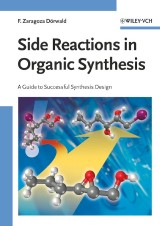Details
Side Reactions in Organic Synthesis
A Guide to Successful Synthesis Design1. Aufl.
|
138,99 € |
|
| Verlag: | Wiley-VCH (D) |
| Format: | |
| Veröffentl.: | 06.03.2006 |
| ISBN/EAN: | 9783527604982 |
| Sprache: | englisch |
| Anzahl Seiten: | 389 |
DRM-geschütztes eBook, Sie benötigen z.B. Adobe Digital Editions und eine Adobe ID zum Lesen.
Beschreibungen
Most syntheses in the chemical research laboratory fail and usually require several attempts before proceeding satisfactorily. Failed syntheses are not only discouraging and frustrating, but also cost a lot of time and money. Many failures may, however, be avoided by understanding the structure-reactivity relationship of organic compounds.<br> This textbook highlights the competing processes and limitations of the most important reactions used in organic synthesis. By allowing chemists to quickly recognize potential problems this book will help to improve their efficiency and success-rate. A must for every graduate student but also for every chemist in industry and academia.<br> <br> Contents:<br> <br> 1 Organic Synthesis: General Remarks<br> 2 Stereoelectronic Effects and Reactivity<br> 3 The Stability of Organic Compounds<br> 4 Aliphatic Nucleophilic Substitutions: Problematic Electrophiles<br> 5 The Alkylation of Carbanions<br> 6 The Alkylation of Heteroatoms<br> 7 The Acylation of Heteroatoms<br> 8 Palladium-Catalyzed C-C Bond Formation<br> 9 Cyclizations<br> 10 Monofunctionalization of Symmetric Difunctional Substrates<br>
ORGANIC SYNTHESIS: GENERAL REMARKS<br> Introduction<br> Synthesis Design<br> Hard and Soft Acids and Bases<br> The Curtin-Hammett Principle<br> STEREOELECTRONIC EFFECTS AND REACTIVITY<br> Hyperconjugation with sigma Bonds<br> Hyperconjugation with Lone Electron Pairs<br> Hyperconjugation and Reactivity<br> Conclusion<br> THE STABILITY OF ORGANIC COMPOUNDS<br> Introduction<br> Strained Bonds<br> Incompatible Functional Groups<br> Conjugation and Hyperconjugation of Incompatible Functional Groups<br> Stability towards Oxygen<br> Detonations<br> ALIPHATIC NUCLEOPHILIC SUBSTITUTIONS: PROBLEMATIC ELECTROPHILES<br> Mechanisms of Nucleophilic Substitution<br> Structure of the Leaving Group<br> Structure of the Electrophile<br> THE ALKYLATION OF CARBANIONS<br> Introduction<br> The Kinetics of Deprotonations<br> Regioselectivity of Deprotonations and Alkylations<br> The Stability of Carbanions<br> THE ALKYLATION OF HETEROATOMS<br> Alkylation of Fluoride<br> Alkylation of Aliphatic Amines<br> Alkylation of Anilines<br> Alkylation of Alcohols<br> Alkylation of Phenols<br> Alkylation of Amides<br> Alkylation of Carbamates and Ureas<br> Alkylation of Amidines and Guanidines<br> Alkylation of Carboxylates<br> THE ACYLATION OF HETEROATOMS<br> Problematic Carboxylic Acids<br> Problematic Amines<br> Problematic Alcohols<br> PALLADIUM-CATALYZED C-C BOND FORMATION<br> Introduction<br> Chemical Properties of Organopalladium Compounds<br> Mechanisms of Pd-Catalyzed C--C Bond Formation<br> Homocoupling and Reduction of the Organyl Halide<br> Homocoupling and Oxidation of the Carbon Nucleophile<br> Transfer of Aryl Groups from the Phosphine Ligand<br> Ipso- vs Cine-Substitution at Vinylboron and -tin Derivatives<br> Allylic Arylation and Hydrogenation as Side Reactions of the Heck Reaction<br> Protodemetalation of the Carbon Nucleophile<br> Sterically Hindered Substrates<br> Cyclometalation<br> Chelate Formation<br> CYCLIZATION<br> Introduction<br> Baldwin's Cyclization Rules<br> Structural Features of the Chain<br> Ring Size<br> Heterocycles<br> MONOFUNCTIONALIZATION OF SYMMETRIC DIFUNCTIONAL SUBSTRATES<br> Introduction<br> Monofunctionalization of Dicarboxylic Acids<br> Monofunctionalization of Diols<br> Monofunctionalization of Diamines<br> Monoalkylation of C,H-Acidic Compounds<br> Monoderivatization of Dihalides<br> <br> <br>
"...I enjoyed reading this book and will refer to it often to help understand problem reactions. Highly recommended..." <br> Organic Process Research & Development<br> <br> <br> "The text in this book is clear, and the diagrams are well presented. There are lots of references, with titles making it easier for the reader to access the value of a reference before they go to find it. The author has worked hard on this book and made a brave effort. Overall, though, it is one for research libraries, but does not merit a personal investment, in my opinion."<br> Journal of the American Chemical Society<br> <br> <br> "The book should be required reading for all who believe that making molecules is an easy task. If, after reading it, they still consider that our organic synthesis is a worked-out branch of science, they must go to the laboratory and try to do it themselves."<br> Miguel A. Sierra, Universidad Complutense, Madrid<br> Angewandte Chemie 2005-117/29 + International Edition 2005-44/29<br>
F. Zaragoza Dorwald studied chemistry at the Georg-August University of Gottingen and Universite Louis Pasteur, Strasbourg, where he obtained his Ph.D. in 1990 on the synthesis of natural products under the guidance of M. Franck-Neumann and M. Miesch. He spent each one postdoctoral year in the groups of A. Pfaltz (University of Basel) and A.P. Marchand (University of North Texas), and worked then on the synthesis of unnatural amino acids at the Technical University of Dresden. Since 1995 he has a position as medicinal chemist at Novo Nordisk A/S, M?l?v, Denmark. His main interests are the development of parallel and solid-phase syntheses for lead identification and optimization.
Most syntheses in the chemical research laboratory fail and usually require several attempts before proceeding satisfactorily. Failed syntheses are not only discouraging and frustrating, but also cost a lot of time and money. Many failures may, however, be avoided by understanding the structure-reactivity relationship of organic compounds.<br> This advanced textbook highlights the competing processes and limitations of the most important reactions used in organic synthesis. By allowing chemists to quickly recognize potential problems this book will help to improve their efficiency and success-rate. A must for every student but also for every chemist in industry and academia.<br> <br> From The Contents:<br> <br> Organic Synthesis: General Remarks<br> Stereoelectronic Effects and Reactivity<br> The Stability of Organic Compounds<br> Aliphatic Nucleophilic Substitutions: Problematic Electrophiles<br> The Alkylation of Carbanions<br> The Alkylation of Heteroatoms<br> The Acylation of Heteroatoms<br> Palladium-Catalyzed C-C Bond Formation<br> Cyclizations<br> Monofunctionalization of Symmetric Difunctional Substrates<br>


















